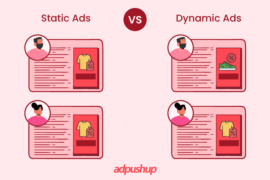Discover the power of behavioral targeting for publishers with our expert tips and best practices. Increase revenue and engagement by delivering personalized content and offers to your audience. Learn how to implement effective strategies today.
Have you ever felt like the ads on the internet have been following you around and keeping a track of your interests? You head to an online store to check out a certain dress, or maybe a shoe, and suddenly its ads start appearing on every website you visit. If yes, you’re welcome to the world of behavioral targeting.
Why should publishers care?
As a publisher, it’s important to stay on top of the several tactics and methodologies of behavioral targeting. Why? Because Behavioral targeting not only enhances the user experience of a website but also serves as a revenue-generating tool for publishers.
Publishers worldwide are relying on behavioral targeting. According to the report, the global behavioral targeting market is expected to witness significant growth by 2029, driven by the rising demand for targeted advertising and personalized user experiences. This presents a huge opportunity for publishers and webmasters to leverage behavioral targeting to increase revenue and engagement.
So without further ado, let’s dive right into the nuts and bolts of behavioral targeting.
Also Read – Ad Targeting: A Publisher’s Guide (with Pros And Cons)
So, what is Behavioral Targeting?
Behavioral targeting is a technique that can be used by publishers, marketers, and advertisers to optimize and improve the effectiveness of their online campaigns.
It works by collecting information about the users, understanding their intent/interest from the information collected, segmenting them, and presenting them with relevant web elements for consumption.
For publishers, it can work wonders since it enhances the user experience, increases conversions, and provide a lot more benefits, which we’ll discuss later in this blog. In fact, as per Digiday, the future of digital advertising lies within the contextual ecosystem. This behavioral targeting cannot be avoided.
We’d look at it, in more detail shortly, but first, let’s look at the main segments which use or should use Behavioral Targeting:
Ad Networks
Behavioral Targeting is used by Ad networks to collect information such as the websites you visit, and how much time you spent on them among other information, to present you with the most relevant advertisements across the ad network. For instance, if you open 3-4 different websites (about business, football, male fashion) that all contain Google ads, Google will know that you are most likely an adult male, interested in sports.
This information can be used to show you more relevant ads, improving your web experience and allowing advertisers to generate higher returns.
E-Commerce (On-Site usage):
Only being used by the big players at the moment – BT can be used by websites to understand the user’s browsing pattern, location, visit frequency, referring source, and search history to present them with personalized content and experience. Amazon has been using this for a long time, so next time when you search for a “sleeping bag”, expect to see other trekking and hiking equipment being recommended to you on the homepage.
Publishers (On-Site usage)
Again, few publishers using it at the moment, primarily to recommend related content, which might be of interest to the visitor. No one uses Behavioral Targeting extensively to improve ad revenues, increase user engagement and improve social sharing.
So how do these websites use Behavioral Targeting? It’s simple. Using Advanced Web Analytics, they can easily measure 50+ attributes about a visitor (including some of them which I mentioned above like the user’s browsing pattern, location, visit frequency, referring source, and search history). And then put the visitor in a segment/bucket/cluster.
Now the campaign manager decides, which attributes would put the user in which bucket and what web elements are to be personalized, and in what way, for different buckets. Don’t worry if it looks difficult to visualize, some examples are coming soon and generally, no programming or technical knowledge is needed, thanks to a lot of GUI-based web personalization tools.
Types of Behavioral Targeting
There are four main types of behavioral targeting: interest-based, demographic, geographic, and psychographic.
Interest-based targeting
It is when ads are targeted based on interests that have been expressed by the user. For example, if someone has expressed an interest in running, they may see ads for running shoes or other running-related products.
Demographic targeting
Demographic targeting is when ads are targeted based on demographics such as age, gender, income, etc. For example, a company may target ads for their new line of makeup to women aged 18-35.
Geographic targeting
It is when ads are targeted based on geographic location. For example, a local business may target ads to people in their city or state.
Psychographic targeting
This is when ads are targeted based on psychological factors such as personality, values, attitudes, etc.
For example, a company may target ads for their new line of organic food to people who are health-conscious.
Benefits of Behavioral Targeting to Visitors/Users
Behavioral targeting has a lot to offer to visitors and users. Here are a few of them:
Content Personalization
When 100 people enter Amazon, they access 100 different homepages, each personalized with their names and with products they have shown interest in their past visits. That is how the entire Internet will soon be.
A study conducted by Adobe and Econsultance, which focused on the ROI of personalization, found that 52% of digital marketers agreed that personalized web content is a very important part of their online strategy. In fact, 41%, of their goal is to provide a personalized internet experience.
Thanks to Behavioral Targeting, users get a better user experience while the publisher achieves its goal resulting in a win-win situation.
Major companies have been collecting user data for years, making their algorithm more exact with their results. With smarter software, the whole internet will be more relevant and efficient to your specific needs.
Also Read – What is Content Personalisation: Benefits, Examples, & Tips
Recognize your Interests
Personality is multi-faceted. People are full of interests. Visiting traveling-related sites doesn’t mean you are only interested in ads from Orbitz or Priceline. Gathering extensive data on demographics over a long period of time will help refine algorithms and take into account the multi-dimensionality of people’s interests.
Saving Users Time
By presenting users with content or offers based on their previous behavior, behavioral targeting reduces the amount of time needed to search for what they are interested in. This way, visitors won’t have to hover around the website looking for what they need. They will already be served the type of content they can relate to.
So you see, Behavioral Targeting can be beneficial to Publishers as well. Have you used Behavioral Targeting on your website or have a case study to share? We’d love to hear!
Top Tips to Boost Your Website’s Performance with Behavioral Targeting
Here are some effective tips to help you optimize your website’s performance using onsite behavioral targeting:
Define Your Goals
First thing first, start by defining certain goals. Ask yourself: what’s the main goal of your website? Do you want to increase newsletter sign-ups, boost your shopping cart conversions, or get more downloads of your guides? Whatever your objective is, make sure it’s something you can measure. That way, you’ll be able to track your progress and see how close you are to reach your target.
Setting clear goals is key to optimizing your targeting strategy. By knowing what you’re aiming for, you’ll be better equipped to make informed decisions and analyze your results. So take some time to define your goals and get ready to see some positive changes on your website.
Revamp Your Website Layout
Publishers can change the overall page layout or the complete user experience on the basis of the information they have about their visitors to improve ad revenue and website earnings. Again, let’s look at a few use cases:
Do you have a regular visitor who consumes content on your website but has never clicked on the ads?
You could look at removing your sidebar ads and putting them around the content for this particular category of users.
Recently, while optimizing revenues for a blog in the Technology niche, The analytics pointed out an interesting fact that Mac users who visited the blog via search engines were more likely to click on text ads than image ads.
The same may or may not be true for your websites, but you can definitely test and then create a BT Segment around it to improve your website’s ad earnings.
Users who are using a very outdated version of Internet Explorer and the old Windows XP OS are likely to be Luddite, you could show a text advertisement with greater contrast to highlight the ad and improve the chances of such users clicking on them.
More page views/visitor
Visitors from Social sites generally have high bounce rates and the average page views per visitor are low. Showing them other related and recommended content from your website, right at the top of your website, before the content, can help reduce the bounce rates.
More comments
A good way to improve comments on your blog would be to create a bucket/segment of users who have not commented on the blog before and reward them when they place a comment. Similarly, you could also display a small widget that shows the Top Commenters on the blog, to motivate this segment to post a comment.
Increasing Content distribution via Sharing
I’m sure everyone has seen those large vertical social sharing bars with a lot of sharing buttons, heck, we have one on our website too, which is probably floating on your right side.
However, a behavior that is seen quite often among all websites, is that a particular user who shares your content would be doing so, only on a single or couple of social sites, the ones where this user is most active.
So, You could look at using Behavioral Targeting to show only those buttons which your user has used often in the past, but this time, you can make them a bit larger.
Similarly, People who come to your website through social sites could be shown a larger Sharing Button, primarily, of the social website, through which they came to the page.
Factors to Keep in Mind When Using Behavioral Targeting
There are a few things to keep in mind when using behavioral targeting.
- First, it is important to make sure that the data you are using is accurate.
- Second, you need to be aware of the potential for privacy concerns.
- And third, you need to make sure that your ads are relevant and not intrusive.
If you keep these things in mind, behavioral targeting can be a great way to improve your advertising results.
Now that you have got a fair idea about behavioral targeting, let’s understand how it differs from contextual targeting.
Behavioral targeting vs. contextual targeting
As mentioned earlier, behavioral targeting is a method of collecting data and using it to target specific audiences to show advertisements according to their browsing behavior on the internment.
In this approach, data analysis and tracking technologies are used to build a profile of a user’s interests and behavior to serve relevant ads based on that profile.
On the other hand, contextual targeting is where ads are displayed according to the content of a particular page. It’s a less personalized approach since it’s not for the individual demographic. The ads in contextual targeting are based on the keyword, topics, and themes that appear on the page.
It’s a great way to reach audiences who are interested in a particular content, product, or service, even if they have no history of showing any specific behavior for it.
Here are their key differences in a nutshell:
| Behavioral Targeting | Contextual Targeting |
| Based on user’s online behavior and interests | Based on the content of the web page |
| Uses data analysis and tracking technologies | Analyzes keywords, topics, and themes |
| Can be highly personalized | Less personalized |
| May raise privacy concerns for users | Less invasive and more privacy-friendly |
| Can be highly effective in reaching interested audiences | May not always reach the most relevant audience |
| Ads are based on user behavior | Ads are based on content on the web page |
Also Read – What is Contextual Advertising? How Does it Work?
Now you must be wondering after all these benefits why behavioral targeting is still not being widely used.
What’s stopping Publishers?
Here is why is it not used so widely.
- The Data Problem –
Websites with very low traffic won’t benefit as the kind of traffic required to first test and then create multiple bucket/segments requires more traffic to be statistically correct.
- Assumptions –
Webmasters assume that BT is a complicated subject and difficult to implement, however, this is incorrect. Similarly, a lot of webmasters assume that products which offer BT must be expensive, which is again not true. A lot of GUI based tools are available which can help you implement Behavioral Targeting on your website for a low two-digit monthly cost.
- Technology –
Although measuring user engagement and social distribution is possible using popular Behavioral Targeting tools, no such tool allows you to measure ad clicks. This is one of the biggest reasons why publishers are unable to use Behavioral Targeting for improving ad revenue and the only alternative is to create custom applications to segments and measure ad clicks, which is a huge task technically.
Closing Words on Behavioral Targeting
In conclusion, behavioral targeting is a powerful tool that can help publishers drive more revenue and engagement. By analyzing user behavior and serving up personalized content and offers, publishers can increase user satisfaction and create a more efficient and effective experience for their audience.
However, it’s important to remember to balance targeted content with user privacy concerns and ensure that data collection and use align with industry standards and regulations.
FAQs – Behavioral Targeting
In behavioral targeting, advertisements and messages are targeted based on people’s activities. To trigger personalized marketing, it uses behavioral data-like what people do in your app, on your website, or with your campaigns.
In behavioral targeting, a detailed user profile is built up and used to deliver better messaging at the right time. In addition, it helps increase advertising campaign KPIs by limiting the possibility of advertisers delivering irrelevant ads.
Developing a strategy for behavioral targeting
1. Take into account how behaviors are interconnected.
2. Prospecting for new customers.
3. Take advantage of opportunities.
4. Make use of an intelligent digital advertising platform.
5. Target people who have already shown interest with remarketing.
6. Take advantage of the low-hanging fruit.
7. Keep email retargeting in mind.

Deepak has a keen eye for detail and a deep understanding of the ad tech landscape. Whether it’s through in-depth articles, thought-provoking insights, or compelling storytelling, he’s dedicated to helping people navigate the complex world of ad tech with the simplicity of his words.







